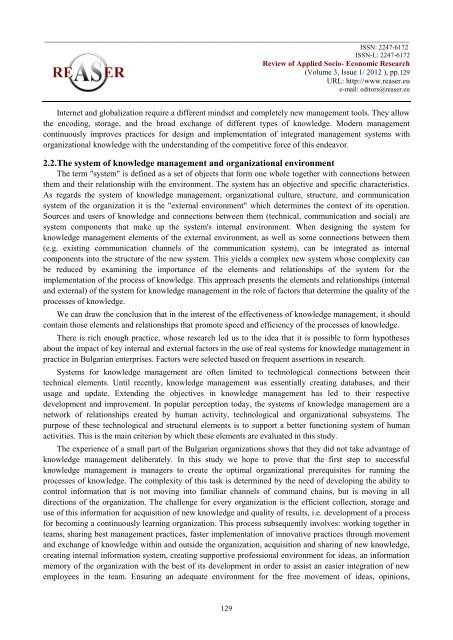Volume 3, ISSUE1/2012 - Review of Applied Socio-Economic ...
Volume 3, ISSUE1/2012 - Review of Applied Socio-Economic ...
Volume 3, ISSUE1/2012 - Review of Applied Socio-Economic ...
Create successful ePaper yourself
Turn your PDF publications into a flip-book with our unique Google optimized e-Paper software.
________________________________________________________________________________________________<br />
ISSN: 2247-6172<br />
ISSN-L: 2247-6172<br />
<strong>Review</strong> <strong>of</strong> <strong>Applied</strong> <strong>Socio</strong>- <strong>Economic</strong> Research<br />
(<strong>Volume</strong> 3, Issue 1/ <strong>2012</strong> ), pp.129<br />
URL: http://www.reaser.eu<br />
e-mail: editors@reaser.eu<br />
Internet and globalization require a different mindset and completely new management tools. They allow<br />
the encoding, storage, and the broad exchange <strong>of</strong> different types <strong>of</strong> knowledge. Modern management<br />
continuously improves practices for design and implementation <strong>of</strong> integrated management systems with<br />
organizational knowledge with the understanding <strong>of</strong> the competitive force <strong>of</strong> this endeavor.<br />
2.2.The system <strong>of</strong> knowledge management and organizational environment<br />
The term "system" is defined as a set <strong>of</strong> objects that form one whole together with connections between<br />
them and their relationship with the environment. The system has an objective and specific characteristics.<br />
As regards the system <strong>of</strong> knowledge management, organizational culture, structure, and communication<br />
system <strong>of</strong> the organization it is the "external environment" which determines the context <strong>of</strong> its operation.<br />
Sources and users <strong>of</strong> knowledge and connections between them (technical, communication and social) are<br />
system components that make up the system's internal environment. When designing the system for<br />
knowledge management elements <strong>of</strong> the external environment, as well as some connections between them<br />
(e.g. existing communication channels <strong>of</strong> the communication system), can be integrated as internal<br />
components into the structure <strong>of</strong> the new system. This yields a complex new system whose complexity can<br />
be reduced by examining the importance <strong>of</strong> the elements and relationships <strong>of</strong> the system for the<br />
implementation <strong>of</strong> the process <strong>of</strong> knowledge. This approach presents the elements and relationships (internal<br />
and external) <strong>of</strong> the system for knowledge management in the role <strong>of</strong> factors that determine the quality <strong>of</strong> the<br />
processes <strong>of</strong> knowledge.<br />
We can draw the conclusion that in the interest <strong>of</strong> the effectiveness <strong>of</strong> knowledge management, it should<br />
contain those elements and relationships that promote speed and efficiency <strong>of</strong> the processes <strong>of</strong> knowledge.<br />
There is rich enough practice, whose research led us to the idea that it is possible to form hypotheses<br />
about the impact <strong>of</strong> key internal and external factors in the use <strong>of</strong> real systems for knowledge management in<br />
practice in Bulgarian enterprises. Factors were selected based on frequent assertions in research.<br />
Systems for knowledge management are <strong>of</strong>ten limited to technological connections between their<br />
technical elements. Until recently, knowledge management was essentially creating databases, and their<br />
usage and update. Extending the objectives in knowledge management has led to their respective<br />
development and improvement. In popular perception today, the systems <strong>of</strong> knowledge management are a<br />
network <strong>of</strong> relationships created by human activity, technological and organizational subsystems. The<br />
purpose <strong>of</strong> these technological and structural elements is to support a better functioning system <strong>of</strong> human<br />
activities. This is the main criterion by which these elements are evaluated in this study.<br />
The experience <strong>of</strong> a small part <strong>of</strong> the Bulgarian organizations shows that they did not take advantage <strong>of</strong><br />
knowledge management deliberately. In this study we hope to prove that the first step to successful<br />
knowledge management is managers to create the optimal organizational prerequisites for running the<br />
processes <strong>of</strong> knowledge. The complexity <strong>of</strong> this task is determined by the need <strong>of</strong> developing the ability to<br />
control information that is not moving into familiar channels <strong>of</strong> command chains, but is moving in all<br />
directions <strong>of</strong> the organization. The challenge for every organization is the efficient collection, storage and<br />
use <strong>of</strong> this information for acquisition <strong>of</strong> new knowledge and quality <strong>of</strong> results, i.e. development <strong>of</strong> a process<br />
for becoming a continuously learning organization. This process subsequently involves: working together in<br />
teams, sharing best management practices, faster implementation <strong>of</strong> innovative practices through movement<br />
and exchange <strong>of</strong> knowledge within and outside the organization, acquisition and sharing <strong>of</strong> new knowledge,<br />
creating internal information system, creating supportive pr<strong>of</strong>essional environment for ideas, an information<br />
memory <strong>of</strong> the organization with the best <strong>of</strong> its development in order to assist an easier integration <strong>of</strong> new<br />
employees in the team. Ensuring an adequate environment for the free movement <strong>of</strong> ideas, opinions,<br />
129








